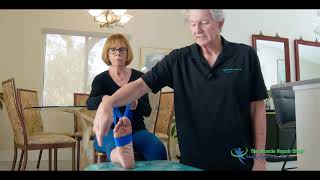Most people know they should stretch, but few know about stretching correctly. Too often they believe that for stretching to be effective it must hurt and you must push yourself to the maximum limit of your range of motion. Nothing could be farther from the truth. If you are like me, you grew up with P.E. coaches and team coaches who pushed us to pull and tug on our bodies, forcing our muscles to extend. I hated stretching because it hurt, and I never felt I was improving all that much. Today, I am discussing the five signs that will let you know you are not stretching correctly.
#1–You Feel Tired After Stretching
I hear from some of my clients that it takes a lot of energy to stretch, or they do not feel a lot of pain when stretching. First, you never want to feel a lot of pain. Having pain means you are either pulling too hard or holding too long. This will tire you out too. I realize that from our past training we were told to pull and pull our muscles like they were taffy. In some of your minds you may think of stretching as pulling the muscle apart, but this is a mistake.
When stretching correctly, you seek to relax your muscles, breathe out and place just enough force on the muscle so the brain can feel which muscle you intend to stretch and then allow it to release. Too much pressure and the brain may get scared and contract the muscle. Holding for too long, the brain may fear an injury and again, contract the muscle. The key here is not feeling pain as a sign you are stretching but, rather, feeling the intended muscle just stretching while you are releasing the emotion from the brain. When you have completed your stretches, you should feel relaxed. Some clients have asked if they could do it in their recliners. The answer is NO! You can do them on the floor or on a hard-backed chair with an ottoman. The recliner will not allow you to be in the correct position. Besides, it was the recliner that helped you get into this stage of stiffness!
#2–You Feel Sore the Next Day
This is a common remark from new clients. Again, this comes from bad advice when we were younger. This is a clear sign you are working too hard when stretching. Remember, we are trying to release tight muscles, not build your biceps. Too many times I see people in the gym trying to stretch and mostly all they are doing is building their biceps.
When stretching correctly, you do not need to manhandle your muscles. Stretching is not forcing the muscle to let go. Your body has built-in protections and if you pull too hard, those protections will fight against you. The reason for the 5 second hold, rather than a longer hold, is to allow the muscle to release before the stretch reflex kicks in to prevent an injury. The 10 repetitions are to train the brain that this movement is safe. Anytime your brain feels unsafe, it will automatically contract the muscle for protection. If that happens, the muscle will feel sore the next day or two and this means you were strength training, not stretching.
#3–You are Trying to Stretch Too Many Muscles at a Time
We’ve all been there. We have joined a stretch class at the gym which had a well-buffed trainer at the front of the room screaming, “Tighten your abs, tighten your hips, now stretch those hamstrings.” Then they will tell you, you are stretching your hamstrings, hips, and calves while building your core. This is a common mistake with muscles. We are told that our bodies, or muscles, are learning, when in fact, it is our brain that is learning. Our body is reactive to whatever we generate in our brain, not the other way around. Think about it for a moment. If a person has a brain injury from a stroke or trauma, the body can become paralyzed. There was no damage to the body, just the brain. If the body has learned how to walk, why would it need the brain to walk again? The truth is, the brain decides when to move, then recruits the appropriate muscles to move before you actually move. Otherwise, the legs would take off before you were ready and that could be a mess! When stretching, focus only on the area you intend to stretch. If you are working on the calves, feel the stretch in the calves and, specifically, the part of the calf you intend to stretch. If you still do not feel anything, ask me what you are doing that is preventing you from feeling the stretch. If you feel pain in any other part of your body, your position may be wrong, or you could be pulling too hard.
#4–Are You a Member of the Checkoff Society?
A professor of mine used to joke about some of her students being members of the Checkoff Society. What she meant was, instead of thinking about what they were doing, they just went down the list of things to do and were satisfied to just complete the list. When she would ask them questions about what they did, many became agitated because many believed they only needed to fulfill the task not actually learn anything. Are you a member of the Checkoff Society?
When stretching, you need to inhale, hold the stretch for five seconds while exhaling, and repeat the stretch ten times. More importantly, you need to focus on what you feel on each stretch. The five-second rule is to prevent the stretch reflex. You need to feel it as the muscle begins to reflex so you know when you need to let go. You need to feel the brain allowing the muscle to relax on each of the ten reps so you can learn how the brain and muscle work together. Notice any improvement in movement, no matter how small, as you are stretching. I want you to learn to relax while stretching so you can feel the difference. I do not care whether you hit the optimal range of motion, or that you can do it better than everyone else. There are no gold stars here, just more pain-free living. This is about learning about your body.
#5–Using the Wrong Type of Strap
It is funny to think about all the different types of straps people have come up with to circumvent the real purpose of why we need to stretch. I have seen rubber tubing, a piece of garden hose, really short belts, or nothing at all used to stretch their bodies. Rubber tubing or anything that stretches should not be used for stretching. If you go to someone who uses a stretchy band of any type, you are in the wrong place. Stretchy bands are used for strength training only. Thinking you are stretching by using no band, is strength training, not stretching because you must use the opposing muscle in the area you are trying to stretch, which is strength training.
When stretching, use an eight-foot yoga strap or rope so you have plenty of length to relax and stretch your muscles. I know you see some fun gadgets on YouTube, but they do not work. Stretching has much more to do with the brain than it does with the muscles. It is true your muscles will get tight from physical movement. However, your muscles will get just as tight from emotional stress and it is easy to miss seeing it happening. Using the correct equipment and the right mindset can make all the difference in the world.
Conclusion
We make stretching much harder than it needs to be which is due to our past training about stretching. Most of our old gym coaches were too stiff to stretch and knew very little about it. Stretching improves joint mobility, disc lubrication in our spines, and improves energy since if takes less energy to move a more flexible body than a stiff one. Take your time, learn a new skill, and free your body to live a more pain-free life. I have included two great stretches that nearly everyone should do daily.
Tips to Improve your Stretching
All you need is a yoga strap and a tennis ball for the tennis ball massage. Give yourself about 15 minutes twice a day and you should see better results within 2 weeks. This, though, is a lifetime event. Think of your pet. they stretch every day and several times a day. Stretch when they stretch. Follow the videos below and free your knees. In my opinion, the calf stretch is the most important stretch a human can do. It will solve many issues of the body.
Stretching is more about feeling the muscles letting go than forcing them to stretch. If you are forcing the muscle, you could be doing strength training, not stretching. Make sure you are feeling the intended muscle stretching. If not, the form could be wrong. Holding for 5 seconds allows the brain to release the muscle before it senses any danger. Repeating the stretches 10 times allows the brain to learn it is safe for the muscle to move that way.
Don’t Forget the Tennis Ball Massage!
Softening your hips and back is easy when you use the tennis ball. Just lean against the wall and apply enough pressure to feel the painful area. The temptation is to press harder but resist it. Instead, breathe out and allow the muscle to soften under the ball. Then move to another spot and repeat. Continue doing this until most of the painful spots are gone. Check out previous newsletters to see the video.
If you like this article, please share with your friends and family. Don’t forget to check out our social media pages, leave a comment, and as always, reviews are awesome!
Want to Talk with Me Directly? Start Here
We’re happy to offer you a complimentary 30-min virtual consultation so you can experience this for yourself. Schedule your introduction to Stretch n Release now.
About The Muscle Repair Shop
Drawing upon his personal experience as a former competitive athlete turned wheelchair, obese, and chronic pain sufferer, Muscle Repair Shop Founder Butch Phelps decided to take his health into his own hands when at the age of 36 he was told he might not make it to his 40th birthday. Applying balanced nutrition advice from his doctor along with a sound exercise program, he went from 315 lbs. to 180 lbs. Motivated by his experience, he then acquired degrees in advanced therapeutic massage and aging sciences to help people eliminate chronic pain. This included applying his expertise in how people age, including the effects of dementia, anatomy, psychology, and the day-to-day struggles living as an older person to his practice and development of The Muscle Repair Shop’s one-of-a-kind Stretch n’ Release Technique.
Available through in-office and virtual coaching treatment sessions, this unique combination of stretching and breath work teaches the brain to release the emotional side of muscle tension and pain allows clients to find lasting relief and healing from stiffness, aches, injuries, and chronic pain. The at-home exercises come with customized instructional videos and virtual or in-office support, allowing clients to enjoy and experience life and sports as they did before limitations slowed or curtailed activities.


